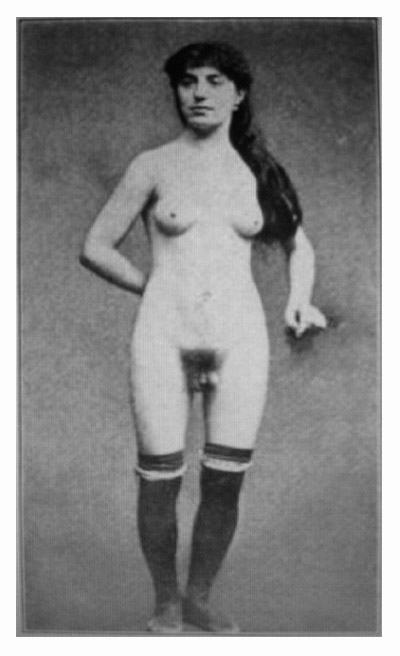
From Hirst: "Fig. 112. — Feminine pseudohermaphroditism?"
The College of Physicians of Philadelphia.

Perhaps next in historical importance is the photograph falling on page 75 of the Mütter book showing what appears to be a case of feminine pseudo-hermaphroditism, if we are to believe the hand written inscription which reads, "Congenital hypertrophy of the clitoris. Ovaries in the labia majora, between which is the vaginal opening." A half-tone of the photograph can be found in the same editions of the White & Martin's 6 as the Robert King Stone dag, with a caption copying what is inscribed on the Mütter photo. The text reference on page 96 is as follows:
Pseudohermaphroditism, in which an individual of one sex simulates in genital conformation that of the other, is a relatively common condition. In males the penis is atrophie, the scrotum bifid, there is perineal hypospadias, and the testicles are undescended; females exhibit hypertrophy of the clitoris (Fig. 52) and absence of vagina, or great reduction of the size of this canal, while the uterus and ovaries may be so small that their palpation per rectum is difficult or impossible.
However, according to Barton Cooke Hirst,7 who reproduced the photograph with the background washed-out to illustrate his textbook on the diseases of women, the source of the image is Dr. Charles W. Fitch from the time when he was in charge of the sanitary service of Salvador, Central America. The following is Hirst's excerpt of Fitch's report to the New York Medical Journal, November 22, 1890 :
J. H. A., a house servant, of masculine features and movements; aged twenty-eight years; height, five feet seven inches; weight, one hundred and thirty-nine pounds; was arrested by the police for violating the law governing prostitution. On examination, both female and male organs of generation were found in a remarkably well developed condition. The labia majora were of normal size, but flattened on their anterior surface. The labia minora and hymen were absent. The vagina was capacious, four and one-half inches long anteriorly and six inches posteriorly. The os uteri was torn on the left side. There was profuse leukorrhea. Seven years before she had given birth to a normal female infant. In place of the clitoris there was a penis, which, when in erection, measured five inches and a quarter long by three and five-eighths inches in circumference. The glans penis and the urethra were perfectly formed. The scrotum, (?) which was two and one-eighth inches long, contained two testicles about an inch in length and two inches and a half in circumference. The mons veneris was sparsely covered with short, straight, black hair. Both sets of organs were perfect in their functions, semen being ejected from the penis (?), and the ovaries being capable of producing eggs. Scanty menstruation occurred every three weeks and lasted but two days. Sexual gratification was said to be equally distributed between the two sets of organs.
Hirst comments that, "Stripped of inaccuracies, this is doubtless a description of a remarkable example of pseudohermaphroditismus feminus." The Fitch report and photographs in the Hirst were part of a chapter titled, Anomalies of development in the genital tract and an earlier edition of Hirst's paper was published as a chapter with the same title in a book by Keating & Coe 8 published in 1895, but there the background of the photograph is not inked-out. There exists, also, a companion photograph showing the subject in an intentionally erotic pose reclining on an Eastlake love-seat and parting the labia with her right hand. It is a detail in the later Hirst, but she can be seen in full composition in the Keating & Coe, with her face expunged:

An explanation of the suggestive poses of both images, but especially of the recumbent figure, can be deduced from the following footnote to the caption in the later Hirst:
This photograph was given the author by an individual who had obtained it from a prostitute. She regarded herself as a woman and had for some years co-habited indiscriminately with men. It may easily have been a case of male pseudo-hermaphroditism.
It is not clear who is meant by "given the author," is it Fitch or Hirst? Laura Lindgren tells me that the Mütter owns both images and Dr. Stanley Burns also owns a copy of the standing pose which he reproduced in his book, A Morning's Work, with the caption: "Hermaphrodite, c. 1883." 9
6.) White & Martin, (page 97).
7.) Hirst, Barton Cooke, (1905), Text-book of diseases of women. Philadelphia: W. B. Saunders & Co.; pages 90-91.
8.) Keating, John Marie, & Coe, Henry Clarke, (1894-) Clinical gynecology, medical and surgical for
students and practitioners by eminent American teachers/ Philadelphia: J. B. Lippincott Company; Page 256 (Plate II).
9.) Burns, Dr. Stanley B. (1998) A morning’s work : medical photographs from the Burns Archive & Collection,
1843-1939. Santa Fe, N.M.: Twin Palms.
